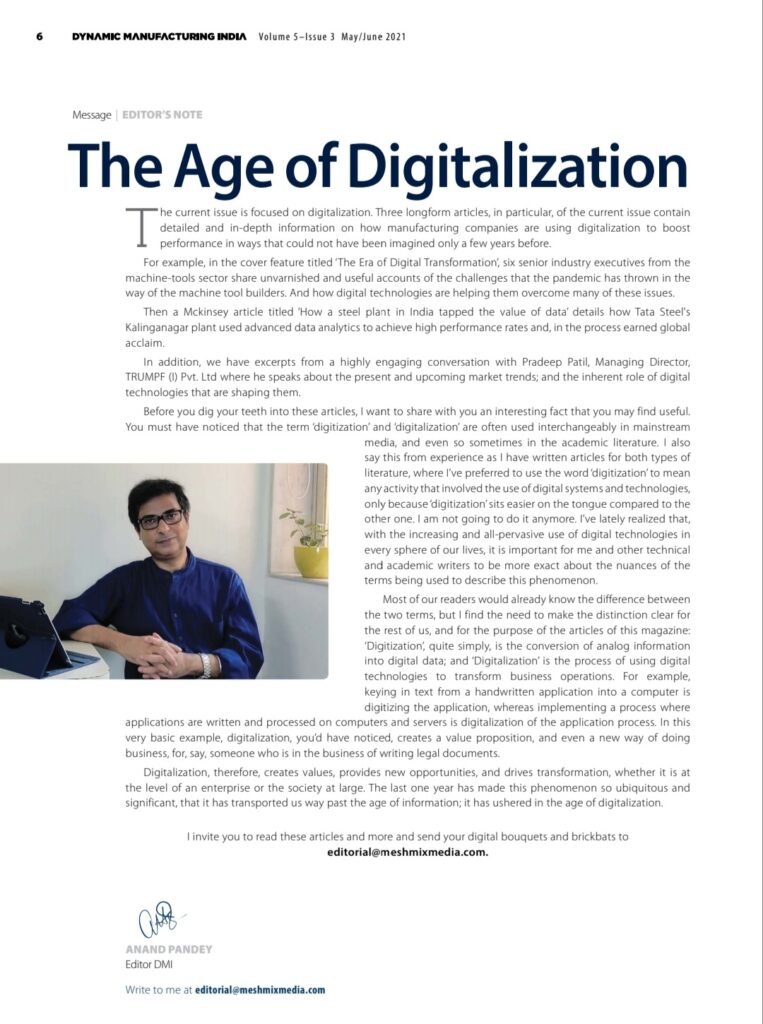The Age of Digitalization

Digitalization’ is the process of using digital technologies to transform business operations
The current issue is focused on digitalization. Three long-form articles, in particular, of the current issue, contain detailed and in-depth information on how manufacturing companies are using digitalization to boost performance in ways that could not have been imagined only a few years before.
For example, in the cover feature titled ‘The Era of Digital Transformation, six senior industry executives from the machine-tools sector share unvarnished and useful accounts of the challenges that the pandemic has thrown in the way of the machine tool builders. And how digital technologies are helping them overcome many of these issues.
Then a Mckinsey article titled ‘How a steel plant in India tapped the value of data’ details how Tata Steel’s Kalinganagar plant used advanced data analytics to achieve high-performance rates and, in the process earned global acclaim.
In addition, we have excerpts from a highly engaging conversation with Pradeep Patil, Managing Director, TRUMPF (I) Pvt. Ltd where he speaks about the present and upcoming market trends; and the inherent role of digital technologies that are shaping them.

Before you dig your teeth into these articles, I want to share with you an interesting fact that you may find useful. You must have noticed that the term ‘digitization’ and ‘digitalization’ are often used interchangeably in mainstream media, and even so sometimes in the academic literature. I also say this from experience as I have written articles for both types of literature, where I’ve preferred to use the word ‘digitization’ to mean any activity that involved the use of digital systems and technologies, only because ‘digitization’ sits easier on the tongue compared to the other one. I am not going to do it anymore. I’ve lately realized that, with the increasing and all-pervasive use of digital technologies in every sphere of our lives, it is important for me and other technical and academic writers to be more exact about the nuances of the terms being used to describe this phenomenon.
Most of our readers would already know the difference between the two terms, but I find the need to make the distinction clear for the rest of us, and for the purpose of the articles of this magazine: ‘Digitization’, quite simply, is the conversion of analog information into digital data; and ‘Digitalization’ is the process of using digital technologies to transform business operations. For example, keying in text from a handwritten application into a computer is digitizing the application, whereas implementing a process where applications are written and processed on computers and servers is the digitalization of the application process. In this very basic example, digitalization, you’d have noticed, creates a value proposition, and even a new way of doing business, for, say, someone who is in the business of writing legal documents.
Digitalization, therefore, creates values, provides new opportunities, and drives transformation, whether it is at the level of an enterprise or the society at large. The last year has made this phenomenon so ubiquitous and significant, that it has transported us way past the age of information; it has ushered in the age of digitalization.
I invite you to read these articles and more and send your digital bouquets and brickbats to editorial@meshmixmedia.com.
By Aanand Pandey
Editor in Chief – Dynamic Manufacturing India
E copy of our Current issue – https://www.machineinsider.com/dmi-may-june-2021/





